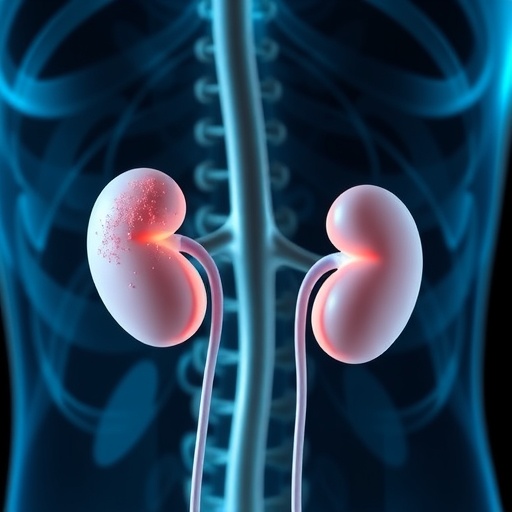In a world where drug therapies are ever-evolving, the safety profiles of commonly used medications remain a crucial area of exploration. The recent research conducted by Wu, Liang, and Liang on the safety of tetracycline highlights the potential for this antibiotic class to induce renal injury. This groundbreaking study brings novel insights into the mechanisms behind such adverse effects, employing advanced methodologies such as network toxicology and molecular dynamics simulations. As antibiotic resistance becomes a global concern, understanding the risks associated with longstanding treatments is of utmost importance.
This comprehensive evaluation of tetracycline’s effects revolves around its biochemical pathways and interactions with renal tissues. Tetracycline, widely known for its bacteriostatic properties, targets bacterial ribosomes but may elicit unwanted toxicological responses in humans. The research uncovers how this drug can disrupt normal cellular functions within the kidneys, emphasizing the necessity for healthcare professionals to weigh the risks when prescribing these antibiotics.
Network toxicology offers an innovative approach to investigating drug safety, utilizing complex biological networks to illustrate drug interactions at the molecular level. By mapping out the connectivity between various proteins and pathways affected by tetracycline, the researchers provided a multi-faceted perspective on how this antibiotic can lead to kidney damage. This state-of-the-art methodology illustrates not just individual pathways but also the interconnectivity that can exacerbate renal injury under certain conditions.
Molecular dynamics simulations further enhance the research findings by providing a visual representation of how tetracycline interacts with renal cell membranes at an atomic level. By utilizing these simulations, researchers can observe real-time molecular movements, gaining priceless insights into structural stability and functionality. Such visual data emerges as a cornerstone of understanding the nuances of drug interactions, painting a clearer picture of the biochemical chaos tetracycline may incite within renal tissues.
A significant aspect of their research focuses on the metabolic byproducts of tetracycline. These byproducts, formed as the drug is metabolized within the body, can exert further stress on kidney cells, leading to the initiation of a cascade of pathological changes. The study highlights how these metabolites may bind to renal cell structures, interfered with normal cellular homeostasis, thereby promoting kidney injury.
The team also draws attention to genetic factors that could influence an individual’s susceptibility to tetracycline-induced toxicity. Variations in renal enzyme expression among patients can lead to drastically different outcomes when exposed to this antibiotic. With personalized medicine becoming a focal point in healthcare, the need to consider genetic predispositions when prescribing tetracycline cannot be overstated.
An essential outcome of this study is the potential for revised clinical guidelines regarding the use of tetracycline for various infections. The findings indicate that clinicians must be judicious in their prescribing habits, especially for populations at risk, including those with pre-existing renal conditions. The increased awareness of potential drug-induced kidney injury could shift the landscape of antibiotic usage, leading to safer and more effective treatment protocols.
Moreover, the implications of this research extend beyond tetracycline itself. It opens avenues for exploring the safety profiles of other antibiotics that belong to the same class or share similar structural characteristics. Understanding drug interaction networks can serve as a model to evaluate the safety of future antibiotic developments, leading to a more robust framework for drug assessments in clinical settings.
Public health implications are profound. Highlighting the potential renal risks associated with tetracycline serves as a warning about the reckless use of antibiotics in treating infections. Educating both medical professionals and patients on the side effects of these drugs could play a critical role in mitigating unintentional harm caused by long-term antibiotic therapy.
This research encourages ongoing dialogue within the medical community about the balance between the benefits of antibiotic treatment and the risks of drug toxicity. Establishing panels for case evaluations and monitoring renal function during antibiotic courses could provide an avenue for earlier intervention should renal injury be detected.
Furthermore, regulatory agencies may need to reconsider labeling requirements for tetracycline and similar drugs to incorporate findings from studies like these. Clear communication of risks associated with kidney injury would enhance patient awareness and understanding, ultimately empowering them to make informed decisions regarding their health.
As the field of pharmacology continues to evolve, findings such as those presented by Wu and colleagues underscore the importance of utilizing a convergence of scientific techniques to improve our understanding of drug safety. By unpacking the complexities of drug interactions through an integrated approach, researchers can deliver substantial contributions towards safer medical practices.
In essence, the study serves as a cautionary tale about the allure of antibiotics like tetracycline, urging a more scrupulous examination of their use in modern medicine. As our understanding of drug toxicity expands through advanced research methodologies, prescribers are increasingly armed with the knowledge necessary to navigate the intricate world of pharmacotherapy.
The dynamics of drug safety reveal an intricate tapestry that intertwines various fields of science, ultimately advancing the goal of safeguarding human health while addressing the critical needs presented by resistant bacterial strains.
Subject of Research: Evaluation of tetracycline-induced renal injury mechanisms
Article Title: Unraveling the mechanism of tetracycline-induced renal injury: an evaluation of drug safety based on network toxicology and molecular dynamics simulations
Article References: Wu, Y., Liang, Y., Liang, J. et al. Unraveling the mechanism of tetracycline-induced renal injury: an evaluation of drug safety based on network toxicology and molecular dynamics simulations. BMC Pharmacol Toxicol 26, 183 (2025). https://doi.org/10.1186/s40360-025-00991-3
Image Credits: AI Generated
DOI: https://doi.org/10.1186/s40360-025-00991-3
Keywords: Tetracycline, renal injury, drug safety, network toxicology, molecular dynamics simulations, antibiotic resistance, pharmacology.
Tags: antibiotic renal injury mechanismsantibiotic resistance concernsbacteriostatic properties of antibioticsbiochemical pathways of tetracyclinedrug safety profiles researchevaluating drug risks in therapyhealthcare implications of tetracyclinekidney damage from medicationmolecular dynamics simulations in toxicologynetwork toxicology in medicinerenal tissue interactions with drugstetracycline kidney health impact





